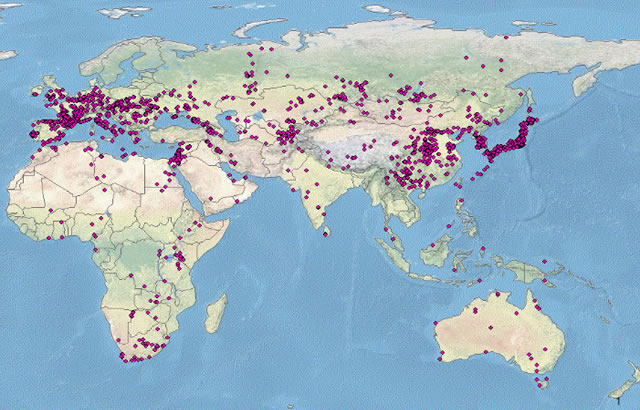A01: A chrono-spatial framework for the emergence of modern humans and their cultures in Asia
Research Organization
- Team Leader
-
- Yoshihiro Nishiaki, Professor
West Asian Archaeology, The University Museum, The University of Tokyo, Japan
- Yoshihiro Nishiaki, Professor
- Co-investigators
-
- Jun Takakura, Assistant Professor
North Asian Archaeology, Archaeological Research Center, Hokkaido University, Japan - Takuya Yamaoka, Associate Professor
Southeast Asian Archaeology, Department of Social and Human Studies, Shizuoka University, Japan - Hajime Ishida, Professor
Physical Anthropology, Graduate School of Medicine, University of the Ryukyus, Japan - Hitoshi Magara, Chief
City History Compilation Office, Board of Education, Uozu City, Toyama Prefecture, Japan - Kazuya Nakagawa, Assistant Chief
Archaeology, Excavation Section, Kyoto-prefecture research center for Archaeologycal propertys, Japan - Shinji Kato, Director
Archaeology, Planning and Coordination Section, Nara National Research Institute for Cultural Properties, Japan - Hiroto Nakata, Lecturer
Japanese Archaeology, College of Literature, Aoyama Gakuin University, Japan - Rikai Sawafuji, JSPS Research Fellow for Young Scientists School of Advanced Sciences
The Graduate University for Advanced Studies (SOKENDAI), Japan - Kenji Suzuki,
National Ainu Museum, Japan
- Jun Takakura, Assistant Professor
- Overseas Collaborators
-
- Wang Youping, Professor
Department of Archaeology, Peking University, China - Otabek Aripdjanov, Vice Director
State Museum of History, Uzbekistan - Sonia Shidarang, Researcher
National Museum of Iran, Iran - James Blinkhorn, Research Associate
Department of Archaeology, Classics and Egyptology, University of Liverpool, UK - Farhad Guliyev, Senior Researcher
Institute of Archaeology and Ethnography, Azerbaijan
- Wang Youping, Professor
- Invited Researchers
-
- Osamu Kondo, Associate Professor
Dept. of Biol. Sciences, Grad. School of Science, The University of Tokyo, Japan - Atsushi Uemine, Program-Specific Assistant Professor
Archaeology, The Hakubi Center for Advanced Research / Institute for Research in Humanities, Kyoto University, Japan - Ryosuke Kimura, Associate Professor
Dept. of Biol. Sciences, Grad. School of Science, The University of Tokyo, Japan - Sadakatsu Kunitake, Associate Reserch Fellow
Nara National Research Institute for Cultural Property, Japan
- Osamu Kondo, Associate Professor
Research
Research Objectives
The A01 research team develops an extensive archaeological database (PaleoAsiaDB) that covers the Middle and Upper Paleolithic sites of Asia in the period ca. 100–20 ka, spanning the time when Homo sapiens is known to have made dispersals into this region. The database comprises a list of related sites, their geographic co-ordinates, and information about stratigraphy, dates, and finds including fossil and lithic remains. The major aim of PaleoAsiaDB is to facilitate investigating variability in cultural dynamism around the time of arrivals of H. sapiens in Asia. The database is also aimed at providing a solid basis on which various models proposed by other research teams can be tested, specifically in relation to dispersals of H. sapiens and their possible interaction with indigenous hominins.
Research Methods
The PaleoAsiaDB is developed as a result of our previous database, NeanderDB, which was produced as part of the RNMH 2010–2014 (Replacement of the Neanderthals by Modern Humans) research project. This initial database dealt with archaeological sites from approximately the same time-span but focused on western Eurasia because it emphasized the distribution and fate of Neanderthals. PaleoAsiaDB, in contrast, targets related sites in central and east Eurasia, allowing comparative analysis of the different regions of Eurasia on a continental scale with the aim of highlighting distinct patterns in the cultural dynamism that appeared and were manifest in Asia around the timing of the emergence of H. sapiens. The structure of PaleoAsiaDB will be adapted from NeanderDB, but modified to accommodate the specific issues posed by the vast geographic extension and the uneven availability distribution of reliable data across regions and/or Asian countries. Moreover, the construction of PaleoAsiaDB involves both systematic investigation of literature as well as original fieldwork and laboratory studies to enrich the data available for regions that lack sufficient chronological and cultural context despite their importance.
